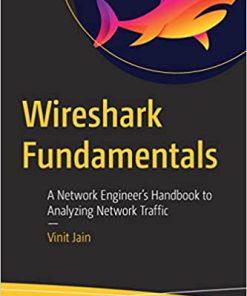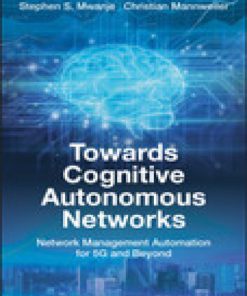Network Architect s Guide to 5G A 1st Edition by Syed Farrukh Hassan, Alexander Orel, Kashif Islam 9780137376704 0137376707
$50.00 Original price was: $50.00.$25.00Current price is: $25.00.
Network Architect s Guide to 5G A 1st Edition Syed Farrukh Hassan Alexander Orel Kashif Islam – Ebook PDF Instant Download/Delivery, ISBN: 9780137376704, 0137376707

Product details:
- ISBN 10:0137376707
- ISBN 13:9780137376704
- Author: Syed Farrukh Hassan, Alexander Orel, Kashif Islam
A Network Architect’s Guide to 5G
Table contents:
Chapter 1: A Peek at the Past
Brief History of Pre-Cellular Mobile Networks
The Very First Cellular Networks: 1G
Innovations in Radio Access
An Introduction to Mobile Transport
Emergence of a Mobile Core
Second Generation (2G) Cellular Networks
2G Innovations in Radio Access
2G Mobile Transport
2G Mobile Core
2G Technology Summary
Generation Two and a Half (2.5G)
Enhanced Data Rates for GSM Evolution (EDGE)
Third Generation (3G)
3G Innovations in Radio Access
3G Mobile Transport
3G Mobile Core
3G Enhancements
3G Technology Summary
Summary
References
Chapter 2: Anatomy of Mobile Communication Networks
Understanding Radio Access Network
How the RF Spectrum Is Allocated
Choosing the Right Frequency
RF Duplexing Mechanisms
Cell Splitting and Sectoring
What’s a Cell Site?
Mobile Transport and Backhaul
What Constitutes Mobile Backhaul Networks?
Cell Site Connectivity Models
Mobile Core Concepts
Circuit Switched Core
Packet Switched Core
Summary
References
Chapter 3: Mobile Networks Today
3GPP Releases and Evolved Packet System
Long Term Evolution (LTE)
System Architecture Evolution (SAE)
Evolved Packet Core (EPC) Architecture
EPC Functions
Data over EPS
Voice over EPS
RAN Evolution
Evolved UTRAN
From Distributed-RAN to Centralized-RAN
Modern Mobile Backhaul Networks
Enabling Technologies for Backhaul Networks
From Backhaul to xHaul
Summary
References
Chapter 4: The Promise of 5G
Emerging Trends and Expectations from Mobile Networks
Increased Speed and Capacity
Content Now
Real-Time and Immersive Experiences
Universal Connectivity and Reliability
Connected Everything
Dedicated Services and Private Networks
On-Demand, Rapid Service Deployment
5G Technology Enablers
New Spectrum and Advanced Antenna Functions
RAN and Mobile Core Decomposition
Networking Slicing
Automation
Mapping 5G Enablers to Market Trends
5G Service Offerings
Enhanced Mobile Broadband (eMBB)
Ultra-Reliable and Low Latency Communications (URLLC)
Massive Machine-Type Communications (mMTC)
Private Mobility
Summary
References
Chapter 5: 5G Fundamentals
5G Radio Access Network
Air Interface Enhancement
5G NR Advanced Antenna Functions
RAN Virtualization and Decomposition
Understanding the RAN Functional Splits
Open RAN
Summarizing vRAN Split Options and Architecture
5G Core Network
Control and User Plane Separation (CUPS)
Towards a Cloud-Native 5G Core
Service-Based Architecture: Decomposition of Packet Core
User Authentication and Registration
Establishing a PDU Session
QoS in 5G
Transition to 5G Core Network
5G Transport Network
Transporting Radio Traffic over Packet-Based Fronthaul
5G xHaul Transport Choices
Incorporating Data Centers into xHaul
Distributed Peering Across xHaul
Summary
References
Chapter 6: Emerging Technologies for 5G-Ready Networks: Segment Routing
Complexity in Today’s Network
Introducing Segment Routing
Concept of Source Routing and Segments
Segment IDs (SIDs) and Their Types
Defining and Distributing Segment Information
Segment Routing Traffic Engineering (SR-TE)
Current Approach to Traffic Engineering
Traffic Path Engineering with Segment Routing
Segment Routing TE Policies
Traffic-Steering Mechanisms
Software-Defined Transport with Segment Routing
Building Blocks for Software-Defined Transport
Application Integration with Transport Network
5G Transport Network Slicing
Network Slicing Options
Segment Routing Flexible Algorithm
Redundancy and High Availability with Segment Routing
Segment Routing Topology Independent Loop-Free Alternate
Segment Routing Loop Avoidance Mechanism
Segment Routing for IPv6 (SRv6)
IPv6 Adoption and Challenges
Segment Information as IPv6 Address
Segment Instructions in SRv6
Implementing Services with SRv6
Summary
References
Chapter 7: Essential Technologies for 5G-Ready Networks: DC Architecture and Edge Computing
Data Center Basics
Rise of Large-Scale Data Centers
Building Blocks of a Data Center Fabric
Considerations for Space, Power, and Cooling
From Centralized to Distributed to Cloud Data Centers
Centralized DC in Mobile Networks
Distributed DC in Mobile Networks
Cloud DC for Mobile Networks
Deploying Data Centers
To Route or Not to Route? That Is the Question
Routing in a Data Center
Traffic Flows in a Data Center
Data Center Interconnect (DCI)
Orchestrating the Data Center Fabric
Optimizing Compute Resources
Why Optimize?
Common Optimization Techniques
Summary
References
Chapter 8: Essential Technologies for 5G-Ready Networks: Transport Services
What’s a 5G Transport Service?
VPN Services
Traditional Layer 2 VPN Services
Layer 3 VPN Services
Ethernet VPN (EVPN)
VXLAN
Transport Services Across MCN
Summary
References
Chapter 9: Essential Technologies for 5G-Ready Networks: Timing and Synchronization
Types of Synchronization
Why Synchronization Is Important in 5G
Synchronization Sources and Clock Types
Implementing Timing in Mobile Networks
Acquiring and Propagating Timing in the Mobile Transport Network
Synchronous Ethernet (SyncE)
Precision Time Protocol
Network Time Protocol
Summary
References
Chapter 10: Designing and Implementing 5G Network Architecture
5G Architecture Recap
5G Fronthaul Considerations
Packetized or WDM Fronthaul Transport?
Fronthaul Bandwidth Considerations
Impact of Lower-Layer Split on Fronthaul Transport
Latency Considerations
Selecting a Far-Edge DC Location
xHaul Transport Technology Choices
Designing the Mobile Transport Network
Physical Topology Considerations
vRAN Deployment Scenarios
Peering Considerations
End-to-End QoS Design
Selecting the Right Network Device
Routing Design Simplification
Designing Multidomain IGP for 5G Transport
Simplification with Segment Routing
Path Computation Element Placement and Scale
Defining SIDs and SRGB
Transport Services for 5G MCN
Taking MCN to the Cloud
Privately Owned Cloud Infrastructure
Building a 5G Network in the Public Cloud
Automation in 5G Networks
Device-Level Automation
Cross-Domain Automation
Closed-Loop Automation: Assess, Automate, Reassess
Deciphering 5G Mobile Requirements
Summary
References
Afterword: Beyond 5G
Index
A
B
C
D
E
F
G
H
I
J
K
L
M
N
O
P
Q
R
S
T
U
V
W
X
Y
Z
People also search:
network architect s guide to 5g
a network architect’s guide to 5g
a network architect’s guide to 5g pdf
5g architecture explained
explain 5g network architecture
You may also like…
Computers - Networking
Computers - Networking
Computers - Web Development
Vue js A comprehensive beginner s guide to Vue js 1st Edition Alexander Aronowitz Rufus Stewart
Computers - Computer Science
Computers - Networking
Computers - Web Development
Vue js A comprehensive beginner s guide to Vue js 1st Edition by Alexander Aronowitz, Rufus Stewart
Biology and other natural sciences - Microbiology
Non-Neoplastic Cytology: A Comprehensive Guide 1st Edition Syed M. Gilani












